First artistic depiction of little known Exodus story uncovered in Galilee
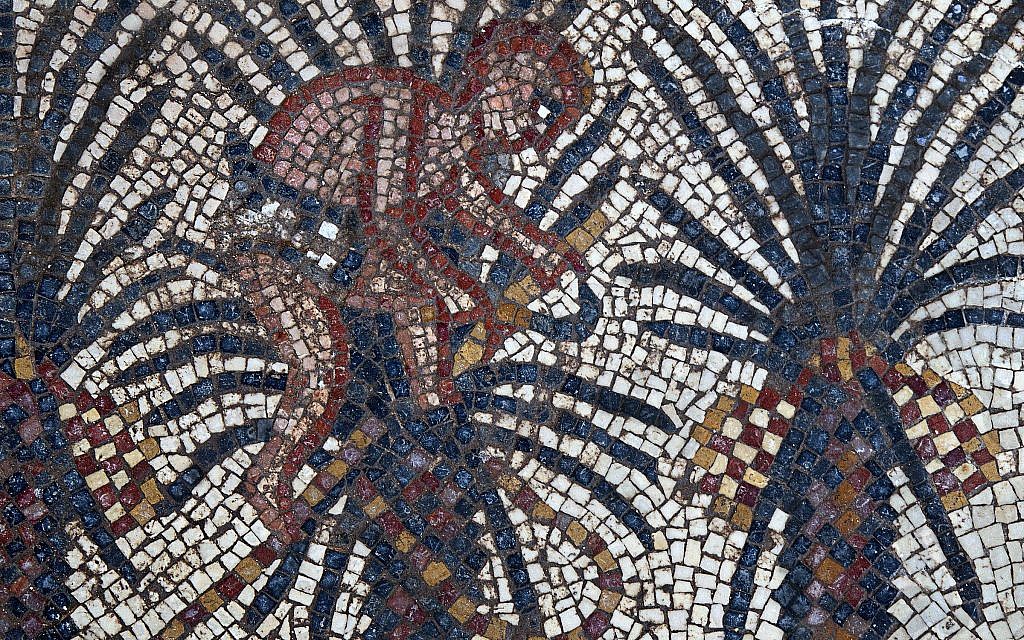 Detail of a mosaic depicting the biblical story of Elim, Exodus 15:27, discovered in 2019 during continuing excavations at a 1,600-year-old synagogue at Huqoq, led by UNC-Chapel Hill Prof. Jodi Magness(Jim Haberman. (Courtesy, UNC-Chapel Hill)
Detail of a mosaic depicting the biblical story of Elim, Exodus 15:27, discovered in 2019 during continuing excavations at a 1,600-year-old synagogue at Huqoq, led by UNC-Chapel Hill Prof. Jodi Magness(Jim Haberman. (Courtesy, UNC-Chapel Hill)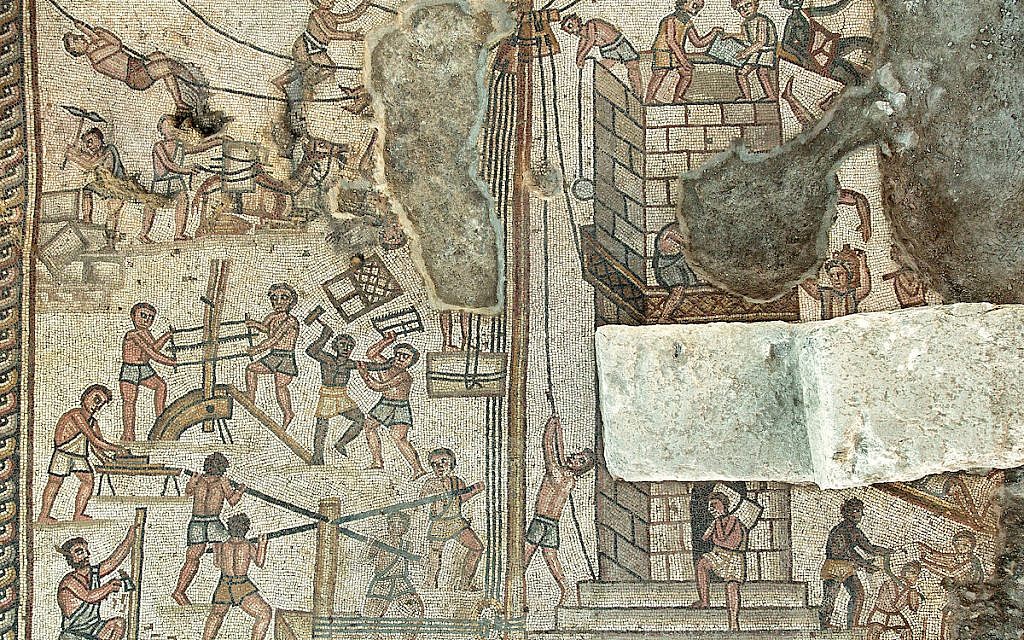 Mosaic depicting the building of the Tower of Babel, Huqoq synagogue. (Jim Haberman)
Mosaic depicting the building of the Tower of Babel, Huqoq synagogue. (Jim Haberman)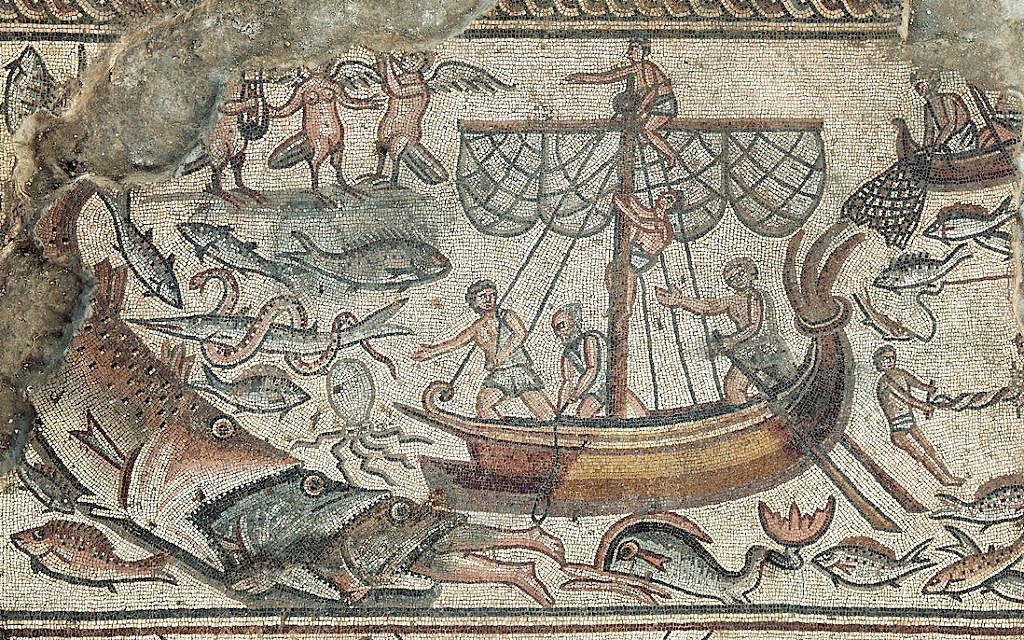 Mosaic depicting Jonah being swallowed by a fish, Huqoq synagogue. (Jim Haberman)
Mosaic depicting Jonah being swallowed by a fish, Huqoq synagogue. (Jim Haberman)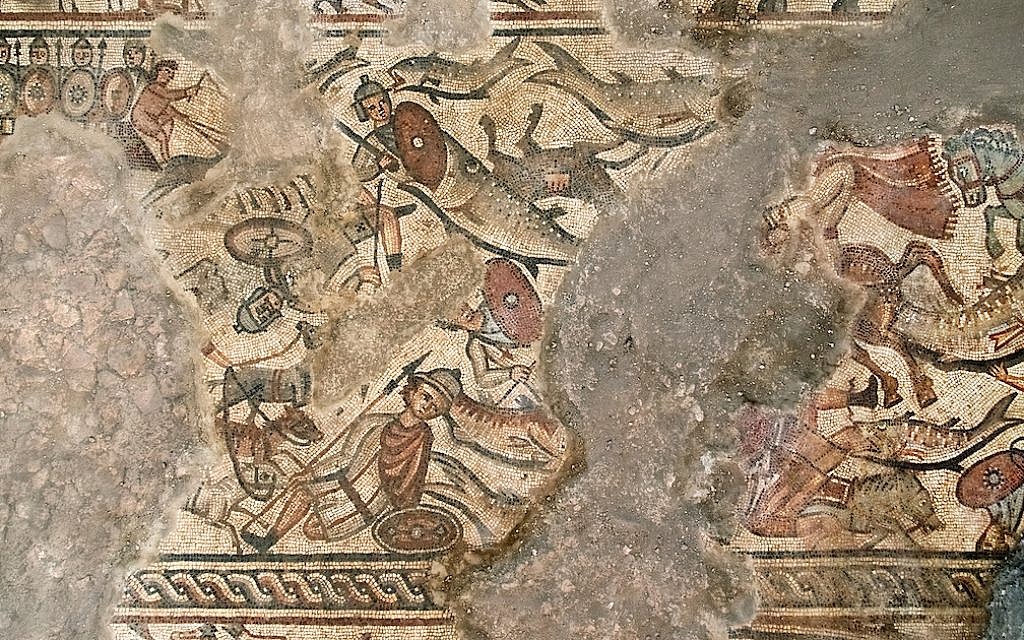 Huqoq mosaic depicting the parting of the Red Sea. (Jim Haberman)
Huqoq mosaic depicting the parting of the Red Sea. (Jim Haberman)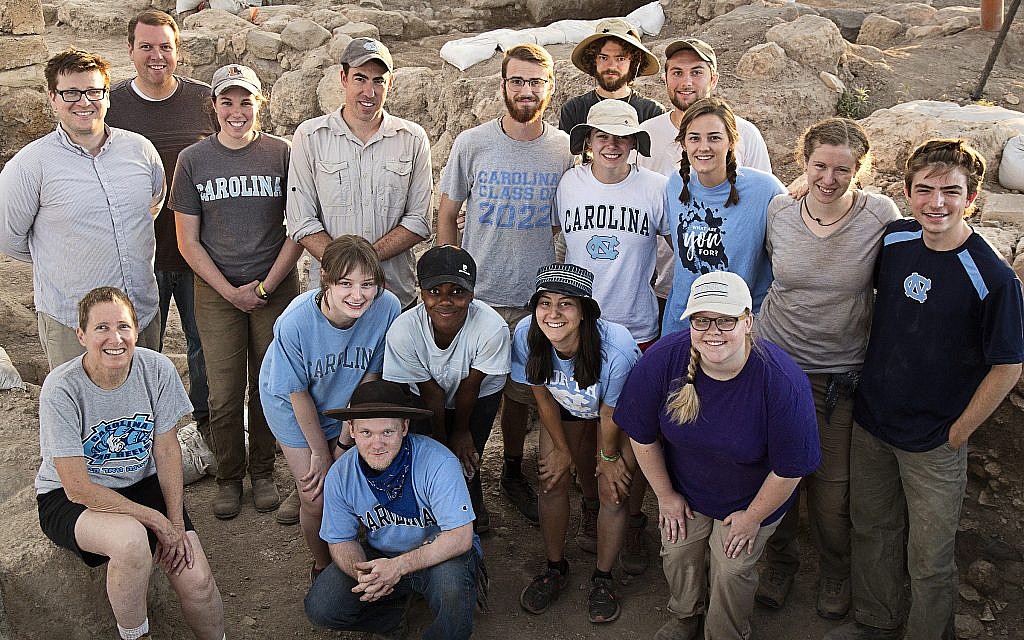 The 2019 crew for the continuing excavations at Huqoq, led by UNC-Chapel Hill Prof. Jodi Magness (far left, seated). (Jim Haberman, Courtesy: UNC-Chapel Hill)
The 2019 crew for the continuing excavations at Huqoq, led by UNC-Chapel Hill Prof. Jodi Magness (far left, seated). (Jim Haberman, Courtesy: UNC-Chapel Hill)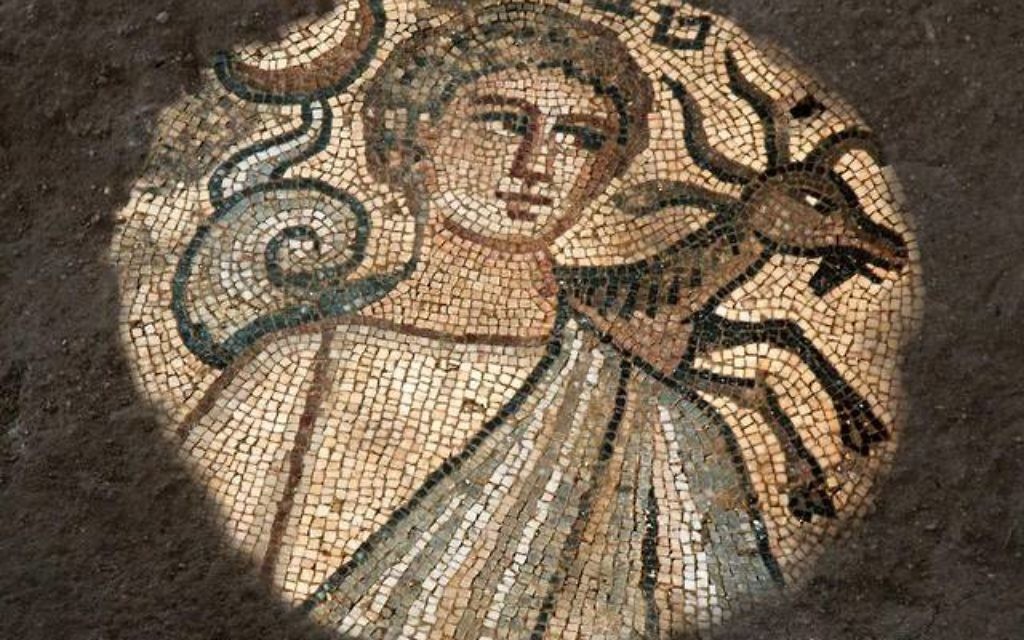 Pictured is the Huqoq synagogue mosaic depicting the month of Teveth (December-January) with the sign of Capricorn. (Jim Haberman UNC Media Relations)
Pictured is the Huqoq synagogue mosaic depicting the month of Teveth (December-January) with the sign of Capricorn. (Jim Haberman UNC Media Relations)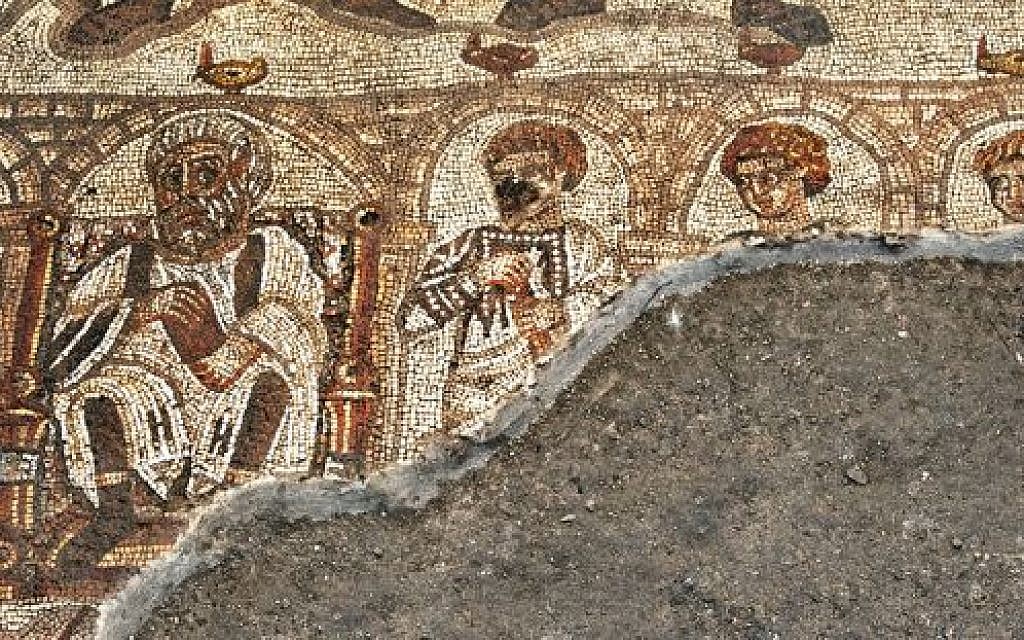 Detail of the Huqoq synagogue's 5th century mosaic, showing the white-bearded elder. (photo credit: Jim Haberman)
Detail of the Huqoq synagogue's 5th century mosaic, showing the white-bearded elder. (photo credit: Jim Haberman)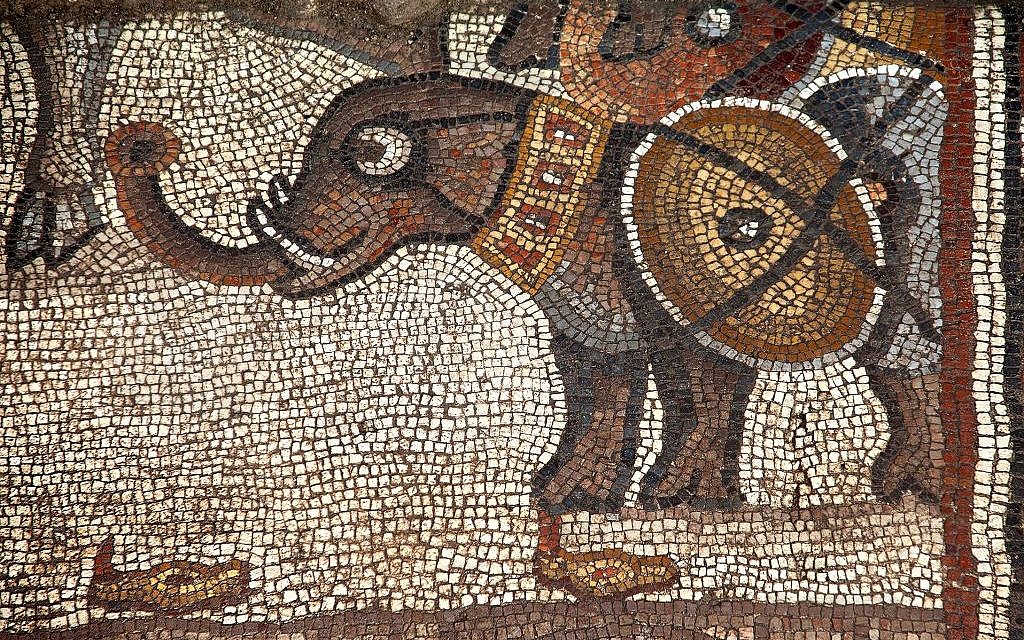 The Huqoq synagogue's 5th century mosaic, with the upper register showing a war elephant. (photo credit: Jim Haberman)
The Huqoq synagogue's 5th century mosaic, with the upper register showing a war elephant. (photo credit: Jim Haberman)
Two new technicolor biblical mosaics were recently uncovered at a
1,600-year-old synagogue in the Galilean town of Huqoq, joining a
growing collection of art, announced UNC-Chapel Hill’s Prof. Jodi Magness on Monday.
The newly unearthed mosaics include the earliest known artistic rendering of the little-known Exodus story of Elim, and a partially preserved depiction of the Book of Daniel’s grotesque four beasts, which signal the end of time. Images of Daniel’s beasts have not yet been released to the media, however, a detail from a mosaic depicting the story of Elim was cleared for publication.
“We’ve uncovered the first depiction of the episode of Elim ever found in ancient Jewish art,” said Magness.
The two new mosaics are part of a growing panoply of dazzling sacred and secular art formed from tiny colorful stones or tesserae that have been uncovered since 2012 by Magness, assistant director Shua Kisilevitz, and a team of archaeologists and volunteers.
Until now, biblical scenes have included well-known stories: Jonah and the whale, the construction of the Tower of Babel, the first spies in Canaan, Noah’s ark, and Pharaoh’s soldiers being swept up in the Red Sea and swallowed up by dozens of fish. Extra-biblical frames on the synagogue floor include a myriad of secular themes, including a zodiac, as well as a portrayal of what is arguably the first purely historical scene in a synagogue.
And now, joining the greatest hits of biblical tales is a brief narrative describing an oasis found at Elim, as described in Exodus 15:27.
The mosaic discovered at Huqoq is divided into three horizontal strips, or registers, said Magness.
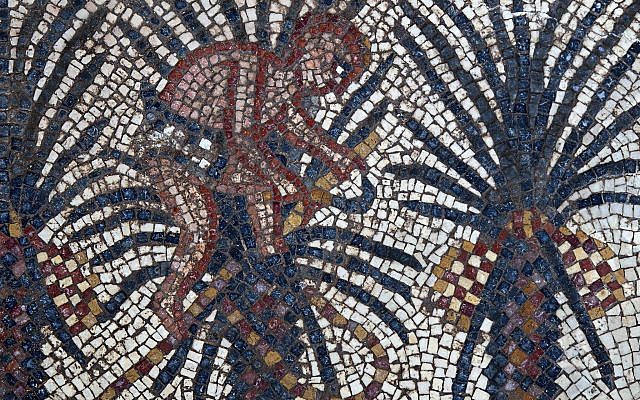 “We see clusters of dates being harvested by male agricultural
workers wearing loincloths, who are sliding the dates down ropes held by
other men. The middle register shows a row of wells alternating with
date palms. On the left side of the panel, a man in a short tunic is
carrying a water jar and entering the arched gate of a city flanked by
crenellated towers,” she said.
“We see clusters of dates being harvested by male agricultural
workers wearing loincloths, who are sliding the dates down ropes held by
other men. The middle register shows a row of wells alternating with
date palms. On the left side of the panel, a man in a short tunic is
carrying a water jar and entering the arched gate of a city flanked by
crenellated towers,” she said.
The identification of Elim in the depiction is confirmed with an inscription above the gate, which reads, “And they came to Elim.”
The Elim panel is interesting to Magness, as it is generally considered a fairly minor episode in the Israelites’ desert wanderings – which raises the question of why it was significant to this Jewish congregation in Lower Galilee,” she said.
According to the biblical commentary of the French rabbinical scholar Rashi (Shlomo Yitzchaki, 1040-1105), who quoted earlier rabbinical sources, the 12 springs of water correspond with the 12 tribes of Israel and the 70 palms are the 70 elders.
As the synagogue is thought to have been constructed in the early fifth century, could the mosaic, assembled in the fifth century, be a subliminal message, harkening to the waning powers of the Great Sanhedrin, disbanded by the Byzantine Empire in 425 CE?
Magness
told The Times of Israel that she does not reject this hypothesis,
however, scholars Ra’anan Boustan and Karen Britt have yet to fully
research and publish their conclusions.
“The lion itself is not preserved, nor is the third beast,” she said. “However, the second beast from Daniel 7:4 – a bear with three ribs protruding from its mouth – is preserved. So is most of the fourth beast, which is described in Daniel 7:7 as having iron teeth,” said Magness.
For Magness, the synagogue’s inclusion of the newly discovered panels is thought-provoking, in terms of what they signified to the residents of Huqoq during that era.
“The Daniel panel is interesting because it points to eschatological, or end of day, expectations among this congregation,” she said.
Previous Huqoq excavations have led Magness to revise previously held conceptions of the practice of Judaism in the Byzantine era.
“The mosaics decorating the floor of the Huqoq synagogue revolutionize our understanding of Judaism in this period,” said Magness in a 2018 press release. “Ancient Jewish art is often thought to be aniconic, or lacking images. But these mosaics, colorful and filled with figured scenes, attest to a rich visual culture as well as to the dynamism and diversity of Judaism in the Late Roman and Byzantine periods.”
In 2011, the relatively untouched and well-preserved Byzantine synagogue was discovered under the rubble of the modern Arab village of Yakuk that stood at the site until intentionally put to fire in 1948. Magness explained in a previous interview with The Times of Israel that her goal was to be able to excavate her own untouched synagogue and methodically analyze the related artifacts to put the site into a clear timeline.
“My hope was to find the building and date it according the archaeological material,” she said. Magness chose to excavate Huqoq, she wrote in a BASOR report, “to clarify the chronology of Galilean-type synagogues, which she believes date to the 4th century CE and later, and thus contemporary with Transitional- and Byzantine-type synagogues.”
Within the first year, her team found ample evidence that dates the site’s synagogue to the early 5th century, which was then confirmed through carbon dating. The first mosaic was uncovered in the dig’s second year and more have been found each year since.
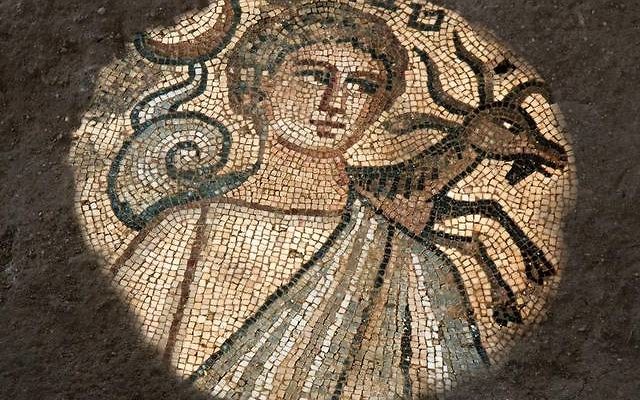 According to Magness, in addition to the mosaics’ artistic worth and
beauty, they are a historical record of the concerns and hopes of the
Jews living in the Galilee 1,600 years ago.
According to Magness, in addition to the mosaics’ artistic worth and
beauty, they are a historical record of the concerns and hopes of the
Jews living in the Galilee 1,600 years ago.
“Our work sheds light on a period when our only written sources about Judaism are rabbinic literature from the Jewish sages of this period and references in early Christian literature. The full scope of rabbinic literature is huge and diverse, but it represents the viewpoint of the group of men who wrote it,” she said.
The work of other groups of Jews have been lost. The rabbis recorded in literature were a “fairly elite” group, she said. Likewise, in the quest to differentiate themselves from their Jewish roots, the writings of early Christians are “generally hostile to Jews and Judaism,” she said.
“So, archaeology fills this gap by shedding light on aspects of Judaism between the fourth to sixth centuries CE – about which we would know nothing otherwise. Our discoveries indicate Judaism continued to be diverse and dynamic long after the destruction of the second Jerusalem temple in 70 CE,” said Magness.
The newly unearthed mosaics include the earliest known artistic rendering of the little-known Exodus story of Elim, and a partially preserved depiction of the Book of Daniel’s grotesque four beasts, which signal the end of time. Images of Daniel’s beasts have not yet been released to the media, however, a detail from a mosaic depicting the story of Elim was cleared for publication.
The two new mosaics are part of a growing panoply of dazzling sacred and secular art formed from tiny colorful stones or tesserae that have been uncovered since 2012 by Magness, assistant director Shua Kisilevitz, and a team of archaeologists and volunteers.
Until now, biblical scenes have included well-known stories: Jonah and the whale, the construction of the Tower of Babel, the first spies in Canaan, Noah’s ark, and Pharaoh’s soldiers being swept up in the Red Sea and swallowed up by dozens of fish. Extra-biblical frames on the synagogue floor include a myriad of secular themes, including a zodiac, as well as a portrayal of what is arguably the first purely historical scene in a synagogue.
And now, joining the greatest hits of biblical tales is a brief narrative describing an oasis found at Elim, as described in Exodus 15:27.
A subliminal tile message?
The story of Elim, largely overlooked in Jewish art until today, occurs shortly after the Israelites fled Egypt, but prior to their long wander in the desert. Elim is described as an oasis, with 12 springs of water and 70 date palms. After a short stay in Marah (a place of bitter water made miraculously sweet), the Elim campsite would have offered a welcome respite.The mosaic discovered at Huqoq is divided into three horizontal strips, or registers, said Magness.

Detail of a mosaic depicting the biblical
story of Elim, Exodus 15:27, discovered in 2019 during continuing
excavations at a 1,600-year-old synagogue at Huqoq, led by UNC-Chapel
Hill Prof. Jodi Magness(Jim Haberman, Courtesy: UNC-Chapel Hill)
The identification of Elim in the depiction is confirmed with an inscription above the gate, which reads, “And they came to Elim.”
The Elim panel is interesting to Magness, as it is generally considered a fairly minor episode in the Israelites’ desert wanderings – which raises the question of why it was significant to this Jewish congregation in Lower Galilee,” she said.
According to the biblical commentary of the French rabbinical scholar Rashi (Shlomo Yitzchaki, 1040-1105), who quoted earlier rabbinical sources, the 12 springs of water correspond with the 12 tribes of Israel and the 70 palms are the 70 elders.
As the synagogue is thought to have been constructed in the early fifth century, could the mosaic, assembled in the fifth century, be a subliminal message, harkening to the waning powers of the Great Sanhedrin, disbanded by the Byzantine Empire in 425 CE?
A beast of a mosaic
A second surprising mosaic was uncovered in the synagogue’s north aisle, with panels depicting beasts that are described in chapter 7 of the Book of Daniel. There, the Babylonian-captive prophet uses the creatures to represent the four kingdoms leading up to the end of days, explained Magness. The identification of the beasts was confirmed through a fragmentary Aramaic inscription referring to the first beast: a lion with eagle’s wings.“The lion itself is not preserved, nor is the third beast,” she said. “However, the second beast from Daniel 7:4 – a bear with three ribs protruding from its mouth – is preserved. So is most of the fourth beast, which is described in Daniel 7:7 as having iron teeth,” said Magness.
For Magness, the synagogue’s inclusion of the newly discovered panels is thought-provoking, in terms of what they signified to the residents of Huqoq during that era.
“The Daniel panel is interesting because it points to eschatological, or end of day, expectations among this congregation,” she said.
Previous Huqoq excavations have led Magness to revise previously held conceptions of the practice of Judaism in the Byzantine era.
“The mosaics decorating the floor of the Huqoq synagogue revolutionize our understanding of Judaism in this period,” said Magness in a 2018 press release. “Ancient Jewish art is often thought to be aniconic, or lacking images. But these mosaics, colorful and filled with figured scenes, attest to a rich visual culture as well as to the dynamism and diversity of Judaism in the Late Roman and Byzantine periods.”
An accidental treasure
Initially, Magness’s excavations of the fifth century synagogue in the small ancient Galilee village of Huqoq were driven by a desire to put to rest a decades-long debate among scholars surrounding the dating of ancient Jewish houses of worship.In 2011, the relatively untouched and well-preserved Byzantine synagogue was discovered under the rubble of the modern Arab village of Yakuk that stood at the site until intentionally put to fire in 1948. Magness explained in a previous interview with The Times of Israel that her goal was to be able to excavate her own untouched synagogue and methodically analyze the related artifacts to put the site into a clear timeline.
“My hope was to find the building and date it according the archaeological material,” she said. Magness chose to excavate Huqoq, she wrote in a BASOR report, “to clarify the chronology of Galilean-type synagogues, which she believes date to the 4th century CE and later, and thus contemporary with Transitional- and Byzantine-type synagogues.”
Within the first year, her team found ample evidence that dates the site’s synagogue to the early 5th century, which was then confirmed through carbon dating. The first mosaic was uncovered in the dig’s second year and more have been found each year since.

Pictured is the Huqoq synagogue mosaic
depicting the month of Teveth (December-January), with the sign of
Capricorn. (Jim Haberman UNC Media Relations)
“Our work sheds light on a period when our only written sources about Judaism are rabbinic literature from the Jewish sages of this period and references in early Christian literature. The full scope of rabbinic literature is huge and diverse, but it represents the viewpoint of the group of men who wrote it,” she said.
The work of other groups of Jews have been lost. The rabbis recorded in literature were a “fairly elite” group, she said. Likewise, in the quest to differentiate themselves from their Jewish roots, the writings of early Christians are “generally hostile to Jews and Judaism,” she said.
“So, archaeology fills this gap by shedding light on aspects of Judaism between the fourth to sixth centuries CE – about which we would know nothing otherwise. Our discoveries indicate Judaism continued to be diverse and dynamic long after the destruction of the second Jerusalem temple in 70 CE,” said Magness.



No comments:
Post a Comment